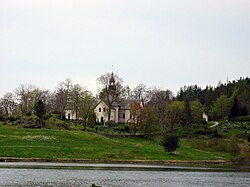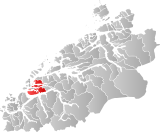Borgund, Møre og Romsdal
Borgund Municipality
Borgund herred | |
|---|---|
 View of the Borgund church | |
 Møre og Romsdal within Norway | |
 Borgund within Møre og Romsdal | |
| Coordinates: 62°27′58″N 06°14′01″E / 62.46611°N 6.23361°E | |
| Country | Norway |
| County | Møre og Romsdal |
| District | Sunnmøre |
| Established | 1 Jan 1838 |
| • Created as | Formannskapsdistrikt |
| Disestablished | 1 Jan 1968 |
| • Succeeded by | Ålesund Municipality |
| Administrative centre | Borgund |
| Area (upon dissolution) | |
| • Total | 172.93 km2 (66.77 sq mi) |
| Population (1968) | |
| • Total | 20,132 |
| • Density | 120/km2 (300/sq mi) |
| Time zone | UTC+01:00 (CET) |
| • Summer (DST) | UTC+02:00 (CEST) |
| ISO 3166 code | NO-1531[1] |
Borgund is a former municipality in Møre og Romsdal county, Norway. The municipality existed from 1837 until 1968 when it was merged into Ålesund Municipality. Borgund originally encompassed the large area north of the Storfjorden and south of the Grytafjorden, from the mainland areas of today's Skodje Municipality in the east to the islands of today's Giske Municipality and the ocean in the west. The city of Ålesund was located in the central part of Borgund, however, was not part of Borgund, and it was governed separately. At its dissolution in 1968, the 172.93-square-kilometre (66.77 sq mi) municipality included the islands of Sula, Humla, Tørla, and Ellingsøya, as well as parts of Oksenøya, Hessa, and Nørvøya, plus many minor islands throughout the area.[2] The main church for the municipality was Borgund Church, located at Borgund (on the western tip of Oksenøya). The administrative centre of the municipality was at Borgund, near the church, along the Nørvasundet strait.
History
[edit]The municipality of Borgund was established on 1 January 1838 (see formannskapsdistrikt law). According to the 1835 census, the municipality had a population of 3,754.[3] In 1849, the eastern district of Borgund including the mainland part of Borgund and the eastern part of Oksenøya island was separated from Borgund to become Skodje Municipality. This left Borgund with 4,461 inhabitants. On 1 January 1908, the islands of Giske, Godøya, and Valderøya in western Borgund were separated from the municipality to become the new Giske Municipality. Borgund then had a population of 6,734. On 1 January 1916, a small part of Skodje Municipality (population: 14) was transferred to Borgund Municipality. Also on 1 July 1958, a small part of Hareid Municipality on the island of Sula, with 68 inhabitants, was transferred to Borgund Municipality.[4]
During the 1960s, there were many municipal mergers across Norway due to the work of the Schei Committee. On 1 January 1965, the northern part of Borgund Municipality (including the Gamlem, Søvik, and Grytastranda areas on the mainland and the islands of Bjørnøya, Terøya and many small islands around them) with 1,191 inhabitants, was administratively transferred into the neighboring Haram Municipality to the north.[4]
Incorporation into Ålesund
[edit]As part of the Schei Committee's report, it was recommended to merge Ålesund and Borgund. There was considerable debate on the incorporation into Ålesund and on what to name the new, larger municipality. The municipal council of Borgund opposed its own incorporation into Ålesund as worked out by the Schei Committee. However, when the Norwegian Parliament agreed to the incorporation, Borgund's municipal council passed a resolution that the new municipality be named Borgund instead of Ålesund. The case went to the Government of Norway, who drafted a resolution that the name Ålesund should be kept. In the Council of State of 10 March 1967, the cabinet Borten agreed to this, except for Per Borten, Kjell Bondevik, Bjarne Lyngstad, and Dagfinn Vårvik who formally dissented—to no avail. The name Ålesund was recommended, and the Norwegian Parliament passed it.[5]
On 1 January 1968, Borgund municipality ceased to exist when it was merged with the town of Ålesund, creating the new Ålesund Municipality. Prior to the merger, Borgund had a population of 20,132. It was the most populous municipality in Møre og Romsdal at the time.[5]
On 1 January 1977, the island of Sula, previously a part of Borgund, was separated from Ålesund to constitute the new Sula Municipality.[4]
Name
[edit]The municipality (originally the parish) is named after the old Borgund farm (Old Norse: Borgund) since the first Borgund Church was built there. The first element is borg which means "castle" or "fortified place". The last element is the suffix -und which means "rich" or "having a lot of something".[6]
Government
[edit]While it existed, this municipality was responsible for primary education (through 10th grade), outpatient health services, senior citizen services, unemployment, social services, zoning, economic development, and municipal roads. During its existence, this municipality was governed by a municipal council of directly elected representatives. The mayor was indirectly elected by a vote of the municipal council.[7]
Municipal council
[edit]The municipal council (Heradsstyre) of Borgund was made up of 41 representatives that were elected to four year terms. The party breakdown of the final municipal council was as follows:
| Party name (in Nynorsk) | Number of representatives | |
|---|---|---|
| Labour Party (Arbeidarpartiet) | 10 | |
| Conservative Party (Høgre) | 4 | |
| Christian Democratic Party (Kristeleg Folkeparti) | 6 | |
| Centre Party (Senterpartiet) | 2 | |
| Liberal Party (Venstre) | 6 | |
| Local List(s) (Lokale lister) | 13 | |
| Total number of members: | 41 | |
| Party name (in Nynorsk) | Number of representatives | |
|---|---|---|
| Labour Party (Arbeidarpartiet) | 8 | |
| Conservative Party (Høgre) | 3 | |
| Christian Democratic Party (Kristeleg Folkeparti) | 6 | |
| Liberal Party (Venstre) | 5 | |
| Local List(s) (Lokale lister) | 19 | |
| Total number of members: | 41 | |
| Party name (in Nynorsk) | Number of representatives | |
|---|---|---|
| Labour Party (Arbeidarpartiet) | 6 | |
| Conservative Party (Høgre) | 2 | |
| Christian Democratic Party (Kristeleg Folkeparti) | 7 | |
| Farmers' Party (Bondepartiet) | 1 | |
| Liberal Party (Venstre) | 5 | |
| Local List(s) (Lokale lister) | 20 | |
| Total number of members: | 41 | |
| Party name (in Nynorsk) | Number of representatives | |
|---|---|---|
| Labour Party (Arbeidarpartiet) | 5 | |
| Liberal Party (Venstre) | 3 | |
| Local List(s) (Lokale lister) | 28 | |
| Total number of members: | 36 | |
| Party name (in Nynorsk) | Number of representatives | |
|---|---|---|
| Labour Party (Arbeidarpartiet) | 4 | |
| Christian Democratic Party (Kristeleg Folkeparti) | 4 | |
| Joint List(s) of Non-Socialist Parties (Borgarlege Felleslister) | 7 | |
| Local List(s) (Lokale lister) | 21 | |
| Total number of members: | 36 | |
| Party name (in Nynorsk) | Number of representatives | |
|---|---|---|
| Labour Party (Arbeidarpartiet) | 4 | |
| Communist Party (Kommunistiske Parti) | 1 | |
| Local List(s) (Lokale lister) | 19 | |
| Total number of members: | 24 | |
| Party name (in Nynorsk) | Number of representatives | |
|---|---|---|
| Labour Party (Arbeidarpartiet) | 3 | |
| Local List(s) (Lokale lister) | 21 | |
| Total number of members: | 24 | |
| Note: Due to the German occupation of Norway during World War II, no elections were held for new municipal councils until after the war ended in 1945. | ||
Mayors
[edit]- 1838–1843: Ferdinand A. Hagerup
- 1843–1845: Ludvig Daae
- 1846–1852: Rasmus Arnet
- 1853–1857: E. Vaagaard
- 1858–1858: Ludvig Daae
- 1872–1893: Colben Aase
- 1893–1895: Johan Nilsen Hoff
- 1896–1913: Carsten Aase
- 1914–1919: L. Nørve
- 1919–1922: Hans Ingvald Hansen Ratvik (V)
- 1923–1925: Martinus Kalvøy
- 1926–1937: Hans Martinusen Blomvik
- 1937–1940: Hans Ingvald Hansen Ratvik (V)
- 1945–1945: Hans Ingvald Hansen Ratvik (V)
- 1946-1947: K. Rødstøl
- 1948-1967: Oddmund Sandvik[16]
See also
[edit]References
[edit]- ^ Bolstad, Erik; Thorsnæs, Geir, eds. (26 January 2023). "Kommunenummer". Store norske leksikon (in Norwegian). Kunnskapsforlaget.
- ^ Store norske leksikon. "Borgund – Møre og Romsdal" (in Norwegian). Retrieved 28 September 2010.
- ^ Registreringssentral for historiske data. "Hjemmehørende folkemengde Møre og Romsdal 1801-1960" (in Norwegian). University of Tromsø. Archived from the original on 23 February 2007. Retrieved 15 October 2006.
- ^ a b c Jukvam, Dag (1999). Historisk oversikt over endringer i kommune- og fylkesinndelingen (PDF) (in Norwegian). Statistisk sentralbyrå. ISBN 9788253746845.
- ^ a b Søberg, Morten (2009). "Usemje rundt Kongens bord". Senatet som aldri vart (in Norwegian Nynorsk). Oslo: Det Norske Samlaget. pp. 47–48. ISBN 978-82-521-7332-1.
- ^ Rygh, Oluf (1908). Norske gaardnavne: Romsdals amt (in Norwegian) (13 ed.). Kristiania, Norge: W. C. Fabritius & sønners bogtrikkeri. p. 178.
- ^ Hansen, Tore; Vabo, Signy Irene, eds. (20 September 2022). "kommunestyre". Store norske leksikon (in Norwegian). Kunnskapsforlaget. Retrieved 1 January 2023.
- ^ "Kommunevalgene 1963" (PDF) (in Norwegian). Oslo: Statistisk sentralbyrå. 1964. Retrieved 16 March 2020.
- ^ "Kommunevalgene og Ordførervalgene 1959" (PDF) (in Norwegian). Oslo: Statistisk sentralbyrå. 1960. Retrieved 20 April 2020.
- ^ "Kommunevalgene og Ordførervalgene 1955" (PDF) (in Norwegian). Oslo: Statistisk sentralbyrå. 1957. Retrieved 20 April 2020.
- ^ "Kommunevalgene og Ordførervalgene 1951" (PDF) (in Norwegian). Oslo: Statistisk sentralbyrå. 1952. Retrieved 20 April 2020.
- ^ "Kommunevalgene og Ordførervalgene 1947" (PDF) (in Norwegian). Oslo: Statistisk sentralbyrå. 1948. Retrieved 20 April 2020.
- ^ "Kommunevalgene og Ordførervalgene 1945" (PDF) (in Norwegian). Oslo: Statistisk sentralbyrå. 1947. Retrieved 20 April 2020.
- ^ "Kommunevalgene og Ordførervalgene 1937" (PDF) (in Norwegian). Oslo: Statistisk sentralbyrå. 1938. Retrieved 20 April 2020.
- ^ Ratvik, Hans (1937). Borgund kommune, 1837-1937: minneskrift (in Norwegian). Ålesund: Borgund kommunen.
- ^ 7"Sandvik gjenvalgt i Borgund". Tidens Krav (in Norwegian). 20 December 1957. p. 6.

